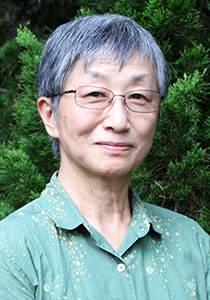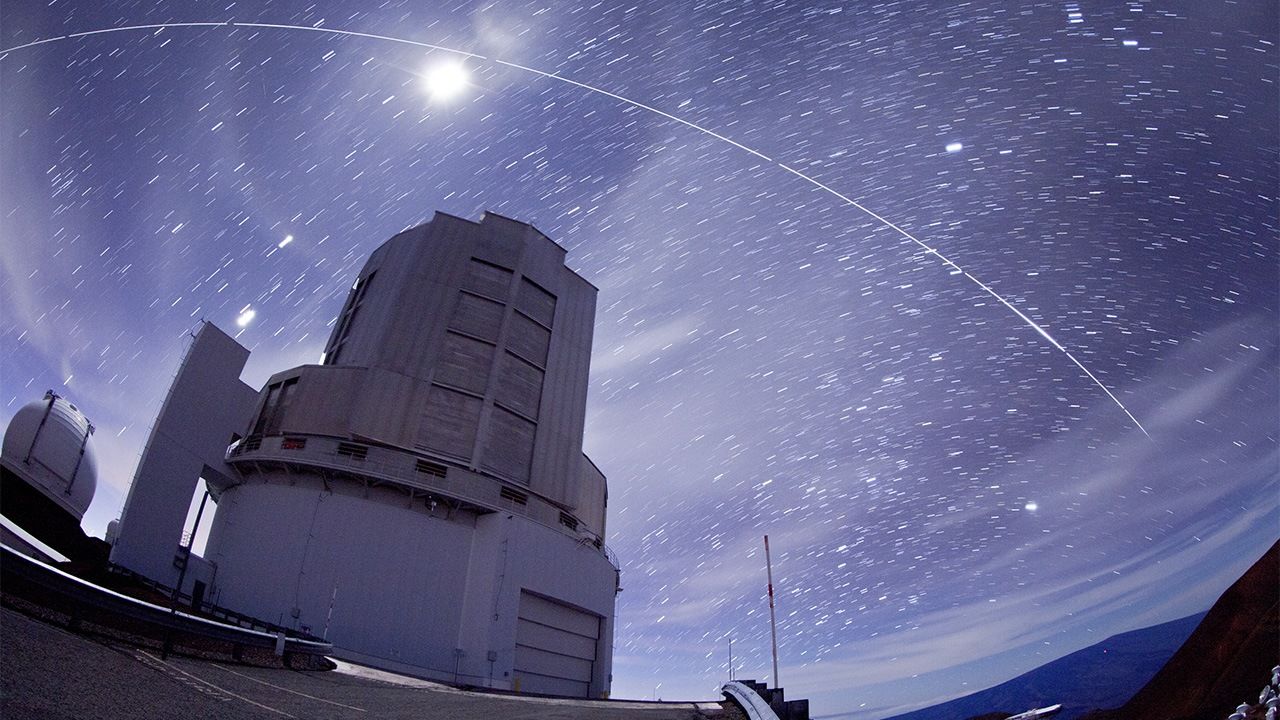
Hayashi Saeko: Three Decades Pushing the Limits of Astronomical Observation with the Subaru Telescope
Science Technology- English
- 日本語
- 简体字
- 繁體字
- Français
- Español
- العربية
- Русский
On September 26, 2019, an international team of astronomers, led by Dr. Harikane Yūichi of the National Astronomical Observatory of Japan, announced the discovery of the most distant, and therefore earliest, grouping of galaxies ever observed—a “protocluster” of 12 galaxies dating back 13.0 billion years. The collaborative effort that produced this important snapshot of the early universe—when it was a mere 800 million years old—began with a wide-field search for protocluster candidates using NAOJ’s Subaru Telescope. This year the telescope is celebrating its twentieth anniversary from its first-light observations.
The desire to peer out into the farthest reaches of the universe has driven the development of ever more powerful telescopes, and a prime site for such facilities is Maunakea on Hawaii’s Big Island. Clustered near the summit, at 4,200 meters above sea level, are 13 telescopes from more than 10 countries. Among them is Japan’s Subaru Telescope. Subaru has been observing the heavens since 1999, and it remains one of the world’s most powerful and technologically advanced reflecting telescopes, with a primary mirror 8.3 meters in diameter.
Over the past two decades, the Subaru Telescope has played a key role in the international quest to unravel the secrets of the universe. Few people are better acquainted with Subaru and its achievements than Hayashi Saeko, who has devoted herself to the telescope since its conception.
Following Her Own Star
Hayashi’s work on the Subaru Telescope has put her on the cutting edge of a field where few Japanese women have ventured. “Even today, it’s pretty uncommon for Japanese girls to choose the math and science track,” remarks Hayashi. “Back when I was in high school, it was very unusual indeed.”
Born in 1958, in the midst of postwar Japan’s “economic miracle,” Hayashi regards the 1969 Apollo 11 moon landing as one of the formative experiences in her life. “I clearly remember the words of my teacher at that time: ‘This is what human beings are capable of accomplishing when they work together.’”
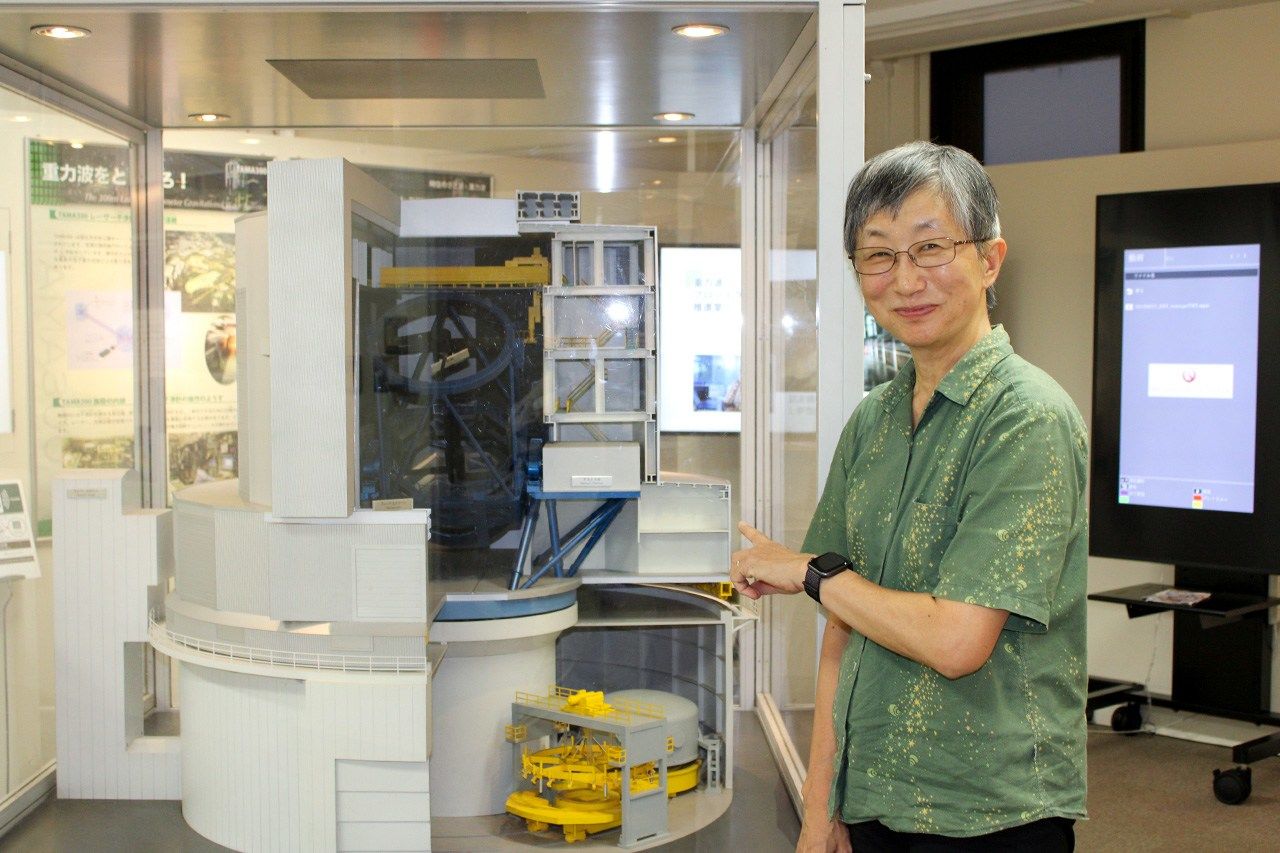
Hayashi beside a model of the Subaru Telescope on exhibit at the National Astronomical Observatory’s headquarters in Mitaka, Tokyo. (© Nippon.com)
As a junior high school student, Hayashi spent most of her spare time either practicing clarinet and bass clarinet (she was a dedicated member of the school band, which practiced nearly every day) or reading. “That was way before the Internet, so books were practically the only way to find out about the rest of the world,” she explains. “I read whatever was on hand in the school library, but my favorites were popular science books by writers like Isaac Asimov or Arthur C. Clarke.”
By high school, she had made up her mind to apply to college as a science major. “The high school I attended was about eighty percent boys, each under intense pressure to get into a top university so that he could get a good job. At the time, society didn’t have high expectations for girls in higher education, so the teachers pretty much left us alone, which was nice. Teaching and nursing were still the major career options for women. I wanted to study geophysics.”
Hayashi’s parents were against it. “I think they worried that such an education would ruin my marriage prospects,” she says with a chuckle. As it happened, Hayashi was living apart from them at the time. Her father had been transferred by his company, and Hayashi had stayed behind rather than transfer to a new school. “I signed up for the [national] university admissions exam without my parents’ knowledge,” she says. Her scores were sufficient to get her into the Faculty of Science at the prestigious University of Tokyo, Japan’s top school for aspiring physicists.
At first, however, it was difficult for Hayashi to share in such aspirations. “There were no role models around, so I found it hard to picture myself actually translating my studies into a career.”
That is what she did nevertheless. Hayashi completed her doctoral studies at the University of Tokyo in 1987. That was the same year the James Clerk Maxwell Telescope, jointly funded by Britain, Canada, and the Netherlands, began operating on Maunakea.(*1) Partly on the strength of her experience at the Nobeyama Radio Observatory in Nagano Prefecture, Hayashi secured a position on the JCMT’s scientific support team, tasked with optimizing the telescope’s performance. “It wasn’t that I was especially good at English or anything,” she says. “I just couldn’t find work inside Japan.”
Accepting the position at JCMT meant living apart from her husband, also an astronomer. But both Hayashis had no hesitation. “There just aren’t that many jobs in the field of astronomy, so we knew this was how it would be when we got married,” she says.
“I’m really glad I had that opportunity to work overseas. The minute you leave Japan, you’re in a different world, where no one cares if you’re a woman or an Asian or what, as long as you work hard and get results. At JCMT, I put in about sixteen hours a day. In the daytime, I’d go up to the telescope on the Maunakea summit for testing and calibration. In the evening, I’d go back down to eat at the dormitory, which was located a little farther down the mountain. Then at night I’d go back up to the telescope to conduct observations based on the calibration information from the night before. I was driven by this compulsion to push the limits of the telescope’s capabilities.”
Birth of a National Project
In 1990, anticipating the approval of government funding for the National Large Telescope project, NAOJ announced an opening for a research assistant, and Hayashi landed the job. “In 1991, the budget request was approved, and we began work, starting with melting glass material for its primary mirror.”
With a primary mirror diameter of 8.3 meters, the telescope envisioned was significantly larger than most advanced optical reflecting telescopes of the time, and it presented a huge technological challenge for Japan. “Until then, Japan’s largest telescope was a mere 188 centimeters — and this was bought from a British supplier; the largest that a Japanese company made was 1 meter. But here we were contemplating a leap to eight meters,” recalls Hayashi. “Some people wondered whether we could pull it off.”
The first question was whether to cast a single monolithic mirror or assemble a segmented one from smaller mirrors. “Above a certain size, either option poses challenges,” explains Hayashi. “With a segmented mirror, it’s very hard to ensure that all the modules remain perfectly aligned. With a monolithic mirror like Subaru’s, the big hurdles are production and transportation, but once the mirror is in place, things become straightforward.”
Production of Subaru’s 8.3-meter monolithic mirror took eight years, from glass melting to polishing. The blank was cast by the US firm Corning Inc., at its plant in Canton, New York, using special ULE (ultralow thermal expansion) glass. Upon completion of the blank in 1994, it was transported by truck to the former Contraves Inc.'s facility in Wampum, Pennsylvania, to be ground and polished. “At the time, people joked that the reason we couldn’t make the mirror in Japan was that the roads in Japan were too narrow. In fact, that really could have posed a problem, given that the load took up all three lanes of a US three-lane highway.”
While the mirror was being fabricated and processed, work was also progressing on the observational instruments to be mounted on the telescope, including an advanced wide-field prime focus camera.

The telescope’s 8.3-meter mirror blank being transported from Canton, New York, to Wampum, Pennsylvania, for polishing in 1994. (© NAOJ)
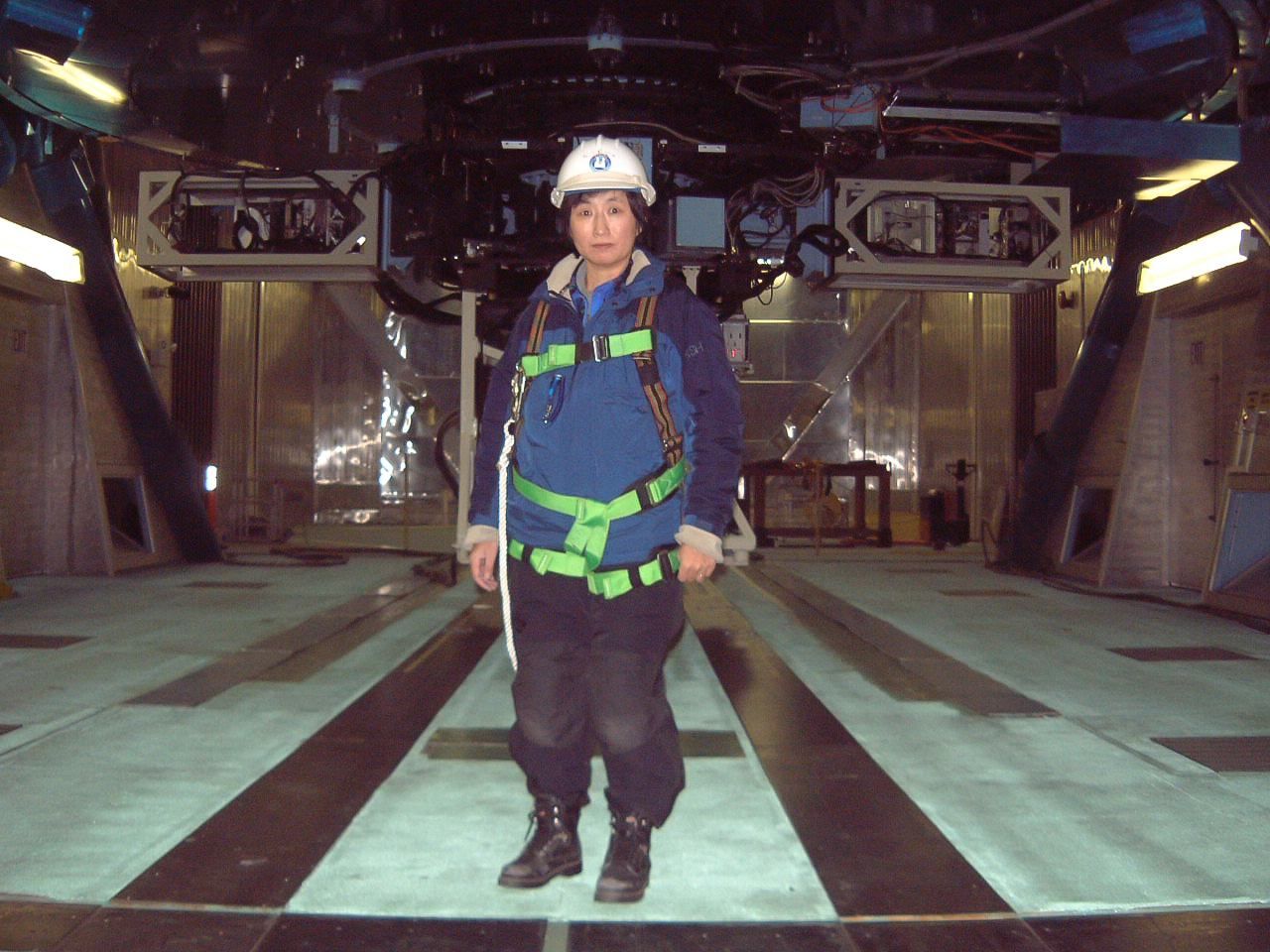
Hayashi Saeko in 2002, photographed in front of the Subaru Telescope. She is wearing a safety harness necessary to operate an aerial lift for the direct inspection of the primary mirror. (Photo courtesy of Hayashi Saeko)
The NAOJ branch office in Hawaii opened in 1997, and Hayashi was assigned there in January 1998. The primary mirror arrived at the observatory in November 1998, and “first light”—the first astronomical observations using the telescope—took place in January 1999.
“This time, my family was there with me,” says Hayashi. “My husband [Hayashi Masahiko] worked on the administrative side; he served as director of the Subaru Telescope from 2006 to 2010. My second son was born in Hawaii.”
Hayashi is one of a staff of about 100, including around 15 scientists. The majority are engineers, technicians, and mechanics, many of whom are from the Big Island, but who also come from other parts of the world. Hayashi’s job is to commission, tune, and maintain the optimum performance of the telescope’s complex optics mechanism. She works closely with the technical team to resolve any issues before the nightly operations. Sometimes that involves arduous manual labor, such as visual inspection of the mirrors using an aerial lift or the removal of snow from the top of the enclosure building. In her determination to facilitate nightly observations, she has sometimes found herself on the narrow rooftop, shoveling snow in the driving wind.
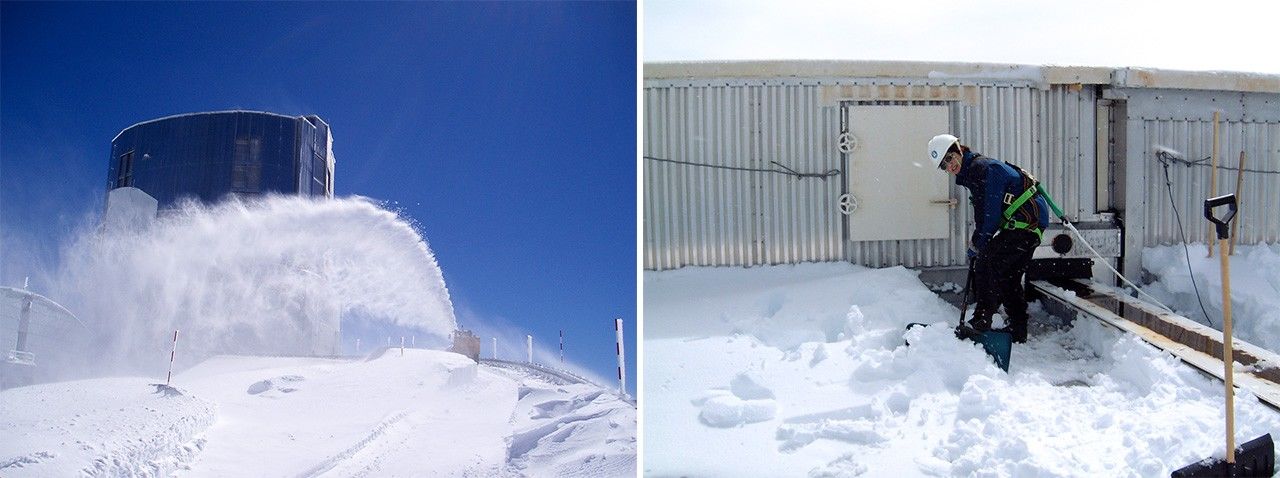
Left: A snow blower clears the access road around the observatory. Right: a native of Japan’s “snow country,” Hayashi is an old hand at shoveling snow off of rooftops. (Photos courtesy of Hayashi Saeko)
A Diverse Community of Telescopes
Most information about the universe comes from electromagnetic radiation of one sort or another. Different types of telescopes are designed to detect different wavelengths of electromagnetic radiation. “From short to long wavelengths, there are gamma rays, X-rays, ultraviolet radiation, visible light, infrared radiation, microwaves, and radio waves. The Subaru Telescope is designed to detect visible light and some infrared radiation,” Hayashi explains. This makes it suitable for direct observations of the light emitted by hot stars and galaxies, as well as infrared rays from lower-temperature objects, such as star “incubators,” and celestial bodies obscured by dust clouds.
Radio telescopes, meanwhile, are designed to detect radiation at the longer range of the spectrum, such as the radio waves emitted by gaseous atoms or molecules swirling around a black hole. In April 2019, a global array of eight ground-based telescopes measured such radiation to capture the first-ever images of a black hole shadow, in an international collaboration involving institutions all over the world, including facilities in Japan and telescopes in Hawaii. Space observatories excel at detecting far infrared and X-ray radiation from outside the earth’s atmosphere; two examples are Akari, Japan’s infrared astronomy satellite (2006–11), and Hinode, a spacecraft that is studying the sun with an X-ray telescope and other detectors. There are also non-electromagnetic wave detectors: One conspicuous case is the gravitational wave telescopes, including the new Kamioka Gravitational Wave Detector (KAGRA) hosted by the University of Tokyo’s Institute for Cosmic Ray Research, designed to detect gravitational waves generated by such rare cosmic events as a collision of two black holes or a supernova. Individually, each type of telescope has its own strengths and limitations; together, they are steadily uncovering the cosmos and its mysteries.
Observational astronomy and telescope engineering have made rapid progress over the past two decades, yet the Subaru Telescope continues to play a crucial role in enhancing our understanding of the universe. “There are two important things that Subaru still does better than almost any other telescope,” says Hayashi. “First, astronomers are always trying to extend their observations farther and farther out into the universe. Through the use of advanced cameras in combination with a powerful, high-resolution telescope to enable wide-field imaging, the Subaru Telescope continues to set new records for the most distant object ever recorded. Another major ambition of astronomers is the discovery of ‘a second earth,’ and Subaru has made an important contribution to this effort through the direct imaging of exoplanets — planets outside the solar system. When it comes to observing the remote universe and imaging exoplanets, the Subaru Telescope stands out from the crowd.”
The first confirmed detection of an exoplanet orbiting an ordinary (main sequence) star was announced in 1995 by a Swiss team, whose leaders were awarded the 2019 Nobel prize in physics for their achievement. These astronomers detected the presence of a planet indirectly, by measuring its subtle gravitational effects, not through direct imaging. This is where Subaru comes in. In 2013, members of the SEEDS project (Strategic Explorations of Exoplanets and Disks with the Subaru Telescope) used a special observational instrument mounted on Subaru to capture an image of the least-massive planet ever directly imaged—a “second Jupiter” orbiting a sunlike star just 60 light years from earth.
A Next-Generation Telescope and the Search for Other Earths
The next goal of exoplanet hunters is to capture an image of an exoplanet closer to the earth in scale and weight, and that is among the objectives of the giant Thirty Meter Telescope project launched by a five-country international consortium consisting of Japan, the United States, Canada, China, and India. The TMT was originally scheduled for completion in 2022, but activists opposing the construction have blocked the access road to Maunakea, which they consider as sacred ground not to be disturbed.
“That’s not the only challenge to finish the construction on time,” Hayashi points out. The blanks for the TMT’s primary mirror are being cast and shaped by Japanese companies using Japanese materials and expertise —a testimony to the leap Japanese manufacturers have made in the past three decades. Unlike Subaru, the TMT will use a segmented mirror assembled from 492 cells. The task of finely grinding and polishing them—the most time-consuming phase—will be divided up among Japan, the United States, China, and India. “It took eight years to finish the primary mirror for the Subaru Telescope,” says Hayashi. “We really need to get down to work.”
Meanwhile, two other consortiums, one European-led and the other centered on a group of US universities, are building the next generation of giant telescopes in Chile. “It’s important to be able to observe the heavens from both the Northern and Southern Hemispheres,” explains Hayashi. “To take two examples, the major galaxy closest to our own Milky Way, M31, can only be seen from the Northern Hemisphere, while the Magellanic Clouds, two dwarf galaxies accompanying the Milky Way, are only visible from the Southern Hemisphere. So, the engineering teams working on these telescopes in the north and south are cheering each other.”
The fate of the TMT telescope site is still a little uncertain, but there is no stopping the humans on this planet yearning to understand the nature and origins of the universe. Asked whether she believes there is intelligent life elsewhere in the universe, Hayashi answers without hesitation: “I do. At the very least, there is some form of life out there. I don’t know of any astronomer who thinks otherwise.”
(Originally published in Japanese based on an interview by Itakura Kimie of Nippon.com. Banner photo: The International Space Station passing over the Subaru Telescope on Mauna Kea. Photo courtesy of Fujiwara Hideaki-Subaru Telescope, NAOJ.)
(*1) ^ In March 2015, the East Asian Observatory, jointly funded and administered by Japan, South Korea, Taiwan, and China, assumed operation of the JCMT.
